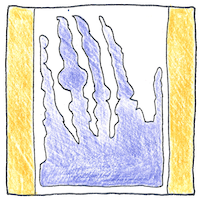Wilhelm Röntgen
electromagnetism

|
X-rays
Wilhelm Conrad Röntgen was experimenting with vacuum tubes that produced streams of electrons, known as cathode rays. He had prepared a cardboard screen painted with barium platinocyanide so it would fluoresce, and he it noticed shimmering when he allowed an electrical discharge to flow through the tubes. In testing the opacity of different materials he moved a piece of lead into the path of the ray and he saw the skeleton of his own hand, holding the dark piece of lead, on the fluorescent screen. He realized that he was seeing a new kind of ray that could go through opaque materials and he called it X-radiation because X in mathematical expressions typically represents the unknown.
X-ray vision
Superman sees through objects with his X-ray vision. How he does this is a matter of poetic license. Neutrino rays even finer than X-rays stream through everything we see but the retinal cells in normal eyes are not fine enough to discern them.
Assertions about radiotherapy
What can kill may be killed. What can kill may heal. What can heal may kill.



The fact that X-rays were a form of electromagnetic radiation of a wavelength comparable to the distance between atoms in a crystal was not shown until 1912.
Röntgen did not try to patent the use of X-rays for medical imaging but said that he preferred that it benefit mankind as a whole. He gave the money for the first Nobel prize in physics to University of Wurzburg. Röntgen did not want X-rays named after himself, as they are today in many languages.
I am not a good one to talk to about trying to kill cancer with radiation. Maybe the good of the whole compensates for individual tragedies.
See also in The book of science:
Readings in wikipedia: